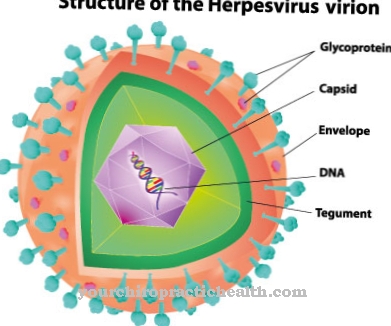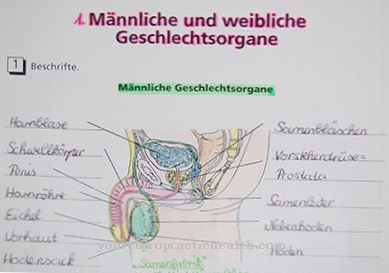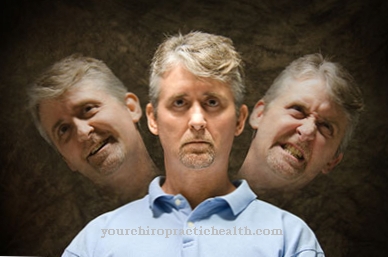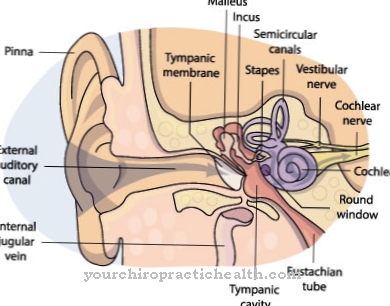As Urticaria pigmentosa is called a form of mastocytosis. It mainly shows up in young children.
What is urticaria pigmentosa?
In the Urticaria pigmentosa it is the most common form of mastocytosis. Mastocytosis is a rare disease in which mast cells accumulate in the skin and in the internal organs. In medicine, the urticaria pigmentosa, which is one of the benign diseases, also carries the name cutaneous mastocytosis.
It differs from systemic mastocytosis in that the mast cells only accumulate in the skin. In the systemic form, on the other hand, organs such as the liver, spleen and intestine are also affected. In addition, the systemic form mainly affects adults, while urticaria pigmentosa mainly affects children.
The disease is not contagious. White blood cells are called mast cells. They can be found in everyone and contain substances such as heparin, serotonin, histamine and various enzymes that are inflammation mediators. The mast cells perform the function of triggering an alarm in the body if they come into contact with pathogens.
In doing so, they release substances such as histamine, which is the prelude to inflammation. This leads to swelling of the skin, expansion of the skin vessels, redness and itching. Furthermore, wheals develop. Urticaria pigmentosa usually appears for the first time during the first 24 months of life.
causes
Urticaria pigmentosa or cutaneous mastocytosis is caused by the accumulation of mast cells in the skin. However, it has not yet been possible to clarify what causes this accumulation. Some doctors suspect the cause of the disease in a genetic defect that triggers uncontrolled growth of mast cells.
There is talk of a point mutation of the c-KIT gene. C-KIT stands for the receptor tyrosine kinase KIT. However, the c-KIT mutation is not the only trigger, since no changes in the c-KIT gene could be detected in many of the children affected. The triggers for the release of the mast cell constituents vary from patient to patient and depend on the type of mastocytosis.
In the case of urticaria pigmentosa, this can be, for example, cold, heat, friction, infection or stress. Food additives, hot spices, allergies, insect venom, alcohol and the use of certain medications such as acetylsalicylic acid, quinine, codeine or narcotics are also possible. Basically, urticaria pigmentosa is a pseudo-allergy that triggers the symptoms.
Symptoms, ailments & signs
The symptoms of urticaria pigmentosa vary greatly from person to person. So they can be both slight and strong. In most cases, the condition affects children, who have reddish-brown patches on the skin, usually on either the torso or thighs.
There are also redness and swellings on the skin and blisters. Itching is often noticeable when rubbing the stains. Wheals later develop. In severe cases of skin mastocytosis, headache, diarrhea, vomiting, and difficulty breathing occur. Even unconsciousness is possible. However, systemic mastocytosis, which also affects the internal organs, only occurs in around 10 percent of all patients.
Diagnosis & course of disease
If urticaria pigmentosa is suspected, the doctor will first interview the patient. It is also based on the typical symptoms of mastocytosis such as spots, wheals and itching. In order to be able to make a reliable diagnosis, the doctor carries out a Darier test. This involves scratching or rubbing an affected area of the skin.
In the event that the area reddens or itches after a few seconds, the Darier test is classified as positive and the suspicion of cutaneous mastocytosis has been confirmed. It is also possible to take a skin sample and examine it in a pathological laboratory. A blood test can also be carried out to determine the triptase value.
In the case of cutaneous mastocytosis, the triptase value is usually normal, while it is higher in the systemic form. The course of urticaria pigmentosa depends on the age of the patient. In children, the spots usually disappear again at the age of two to three years. A chronic form is rare. This can cause problems even for adults. But the prognosis is usually positive for adults too.
Complications
The exact complications and symptoms of urticaria pigmentosa depend very much on the severity of the disease, so that a general prediction is usually not possible. However, patients suffer from spots that appear on the skin. These spots are reddish or brownish and have a negative effect on the aesthetics of the person concerned.
For this reason, many sufferers suffer from inferiority complexes or are ashamed of the disease. As a result, children can be bullied or teased. There is also severe itching. Urticaria pigmentosa can also lead to severe headaches or diarrhea and vomiting. In serious cases, this leads to unconsciousness, which can injure the person concerned.
The disease can also lead to breathing difficulties, so that the patient's quality of life is significantly restricted and reduced. Treatment of urticaria pigmentosa is carried out with the help of drugs. Since it cannot be carried out causally, those affected are dependent on taking the medication. Usually there are no complications. The life expectancy of the patient is also not reduced by the disease.
When should you go to the doctor?
Medical treatment by a doctor should always be provided for urticaria pigmentosa. Further complications can only be prevented with proper treatment, as it cannot heal itself. An early diagnosis always has a very positive effect on the course of the disease and can also prevent the symptoms from worsening. A doctor should be contacted if the affected child has had severe headaches, vomiting or diarrhea for a long time.
Severe breathing difficulties can also indicate the disease, and some patients may even lose consciousness. If these symptoms occur for no particular reason and do not go away on their own, you must definitely see a doctor. The disease can be diagnosed and treated by a pediatrician or a general practitioner.
There are no particular complications, so that the life expectancy of the child is usually not reduced by urticaria pigmentosa. If urticaria pigmentosa is a chronic disease, it is advisable to visit a doctor regularly to monitor the condition of the internal organs.
Treatment & Therapy
Urticaria pigmentosa does not always have to be specially treated because it often disappears on its own in children. In adult patients, it is important to determine the exact cause. The triggering triggers for the release of the mast cells must be consistently avoided. These mostly include friction, stress, abrupt temperature changes or insect bites.
A complete cure of mastocytosis is not possible. However, the symptoms of the disease can be effectively relieved by administering drugs such as antihistamines. These inhibit the effect of the released histamines. In addition, so-called mast cell stabilizers can be used, which ensure that the mast cells release less histamines. For this purpose, the patient is usually given metered dose aerosols, nasal drops or eye drops.
prevention
Urticaria pigmentosa cannot be prevented directly. However, it is possible to avoid the triggering stimuli, for example by avoiding special medication or food.
Aftercare
The extent of the follow-up measures for Urticaria Pigmentosa (UP) is determined by the respective clinical picture and age of the person affected.In affected children, for example, urticaria pigmentosa can lead to spontaneous blistering of the skin in early childhood (up to three years of age). Due to external stimuli (for example heat / cold or infections), the blisters regularly burst. The task of aftercare is then to prevent scarring by applying healing ointments.
Urticaria pigmentosa is fundamentally incurable. In the further development of the affected children, the mast cells in the body do not multiply properly. There are too many. The too many mast cells manifest themselves in 95 percent of all cases of illness as red-brown to brown spots on the skin of the person affected. When exposed to external stimuli, the spots release histamine. The focus of aftercare is then on treating the symptoms triggered by the histamine.
Depending on the severity of the symptoms (for example an attack-like drop in blood pressure or anaphylaxis), clinical stays may also be necessary to regenerate the state of health. The person affected can relieve symptomatic external skin irritation (for example, itching, swelling or redness) by applying cortisone ointments and treating sudden headaches or painful limbs with medication. In the remaining five percent of all cases of illness, those affected have no complaints. There is then no need for follow-up measures.
You can do that yourself
Urticaria pigmentosa requires medical clarification. The skin condition can be treated with various home remedies and self-help measures.
The first thing to do is to cool the affected regions sufficiently. Abrupt temperature changes and mechanical irritation should be avoided. The medically prescribed medication must be taken according to the doctor's instructions. At the same time, possible triggers must be eliminated. Causal drugs such as codeine, procaine or polymyxin B must be checked and, if necessary, discontinued. In addition, a comprehensive physical examination is necessary as there may be undetected comorbidities.
Itching or redness is also treated using various natural remedies. Graphites D12 can be used for dry skin. Severely itchy rash is treated with Petroleum rectficatum D12. The use of alternative means must first be discussed with the responsible doctor.
In the case of chronic urticaria pigmentosa, lifestyle habits must be adjusted. Diet, personal hygiene and physical activity all influence the course of the disease. A healthy and balanced diet without irritating substances applies. Patients should care for the skin daily and otherwise take it easy. The responsible dermatologist explains which self-help measures make sense in detail.





.jpg)







.jpg)

.jpg)
.jpg)











.jpg)